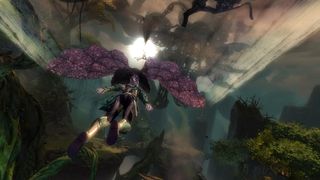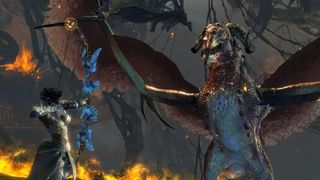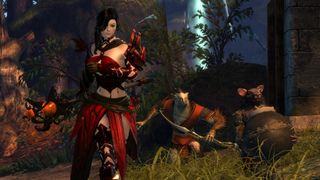Guild Wars 2: Heart of Thorns hands-on – entering the jungle

Mastery and Commander
The other icon on the map is for a Mastery Point. I can't find it, which suggests these are the map's new collectibles—a sort of Vista mixed with Skill Point. In Heart of Thorns, clicking on the XP bar opens up the mastery menu. Here, players can select their desired upgrade, and any XP gained from that moment goes towards filling its unlock bar. Once unlocked, it can be bought with Mastery points.
This, ArenaNet says, is GW2's new end game system. Masteries are divided between Heart of Thorns specific unlocks—hang-gliders, mushroom jumping and bonuses against the jungle's enemies—and more general game-wide upgrades. Each mastery is divided up into multiple stages, each providing additional bonuses but costing more points. In this sense, it functions a little like the existing world-versus-world skills.
Only two game-wide masteries are in the demo build: Fractal Attunement Mastery and Legendary Precursor Crafting. The latter will allow players to craft precursors—exotic weapons that form the basis for legendaries. It gives players a more sure-fire way to acquire the weapons—currently it's a complete gamble. The final stage of the mastery line unlocks the new precursor weapons being introduced for Heart of Thorns.
Misty eyed
Heart of Thorns' new profession is the Revenant—a heavy-armoured class that works a bit like the elementalist, only with history instead of magic. Like the elementalist, Revenants can't weapon-swap during combat. Instead, they equip and swap between "legends" of the past. Two legends can be equipped at a time, and in the demo I had access to both Mallyx the Unyielding and Jalis Ironhammer.

With a press of F1 I'm able to switch the currently active legend. Legends define the last five positions on the hotbar—healing, utility and elite skills. With Jalis, that means hammer stuff. He's a dwarf king, and his stone-based attacks let me channel a pair of hammers to continuously circle around me, smacking everything in their way. He's simple, fun and offers options that can increase the survivability of me and my allies.
PC Gamer Newsletter
Sign up to get the best content of the week, and great gaming deals, as picked by the editors.
Mallyx is a more complicated legend. To play him effectively, I need to collect conditions. He's not very powerful in and of himself, but his healing skill is more potent if I'm loaded with negative status effects. All of his skills work in a similar way—providing extra bonuses the more debuffs I've accrued. It's a high-risk style, and one that could lead to some dramatic turnarounds for those who learn to play it well.
The other legends weren't available, but if they can provide additional systems as divergent as the two on offer, the Revenant should offer lots of scope for tailoring builds to specific play styles. Put another way, I may be about to make my first heavy character.
Home of Champions
My final stop was Champion's Dusk, the new PvP map. It's Guild Wars 2's first Strongholds map—a mode I detailed last month. Each team's objective is to break into their opponent's stronghold and kill their lord. To do this, they need to collect supply from the centre of the map, and spend it on NPC units back at their barracks. It's tactical, and also somewhat chaotic. The action moves much faster than I expected—even our longest matches only take ten minutes or so.

In one game, the enemy goes fully on the offensive. They spawn multiple doorbreakers, and babysit them to our gate. It's over quickly, our team too spread out and focused on individual objectives to mount a coordinated defence. It becomes clear that the mode rewards group play—either of existing parties or the planned Guild-versus-Guild matchmaking. Our less organised team is destroyed.
We find more success in our other game. This one goes on longer, and we're able to control the middle supply line, preventing our opponents from calling in NPCs. I play a roaming Thief, and help out by picking off lone enemy players and protecting allies while they channel the hero summon that spawns periodically throughout the map. If there's one thing I'm unsure about, it's the team size. Five players per team is too few to utilise all of the map's systems, and while planning around that is a key part of a team's tactics, it makes it difficult to rally from a weak early game.
What I've played is a promising sign that Heart of Thorns will be a meaningful expansion. The small demo area felt like a continuation of the design lessons learned over the last two years of updates. If ArenaNet continue to expand and escalate the available events throughout the new area, Heart of Thorns should be an expansion that provides plenty of difficult content for players to tackle. There are still questions—of the full size of the expansion, of how much its challenge will progress beyond what players have previously experienced, and of whether the new events hold up to repetition in any meaningful sense. If these concerns are answered, Heart of Thorns will be a great showcase for this new phase of Guild Wars 2's life.

Phil has been writing for PC Gamer for nearly a decade, starting out as a freelance writer covering everything from free games to MMOs. He eventually joined full-time as a news writer, before moving to the magazine to review immersive sims, RPGs and Hitman games. Now he leads PC Gamer's UK team, but still sometimes finds the time to write about his ongoing obsessions with Destiny 2, GTA Online and Apex Legends. When he's not levelling up battle passes, he's checking out the latest tactics game or dipping back into Guild Wars 2. He's largely responsible for the whole Tub Geralt thing, but still isn't sorry.
Most Popular




